JVM 性能调优监控工具 jps、jstack、jmap、jhat、jstat、hprof 使用详解
- JVM学习系列
- 时间:2021-08-11 09:43
- 5643人已阅读
🔔🔔🔔好消息!好消息!🔔🔔🔔
有需要的朋友👉:联系凯哥
OutOfMemoryError,内存不足 内存泄露 线程死锁 锁争用(Lock Contention) Java进程消耗CPU过高 ......
jps [options] [hostid]
如果不指定hostid就默认为当前主机或服务器。
命令行参数选项说明如下:
-q 不输出类名、Jar名和传入main方法的参数 -m 输出传入main方法的参数 -l 输出main类或Jar的全限名 -v 输出传入JVM的参数
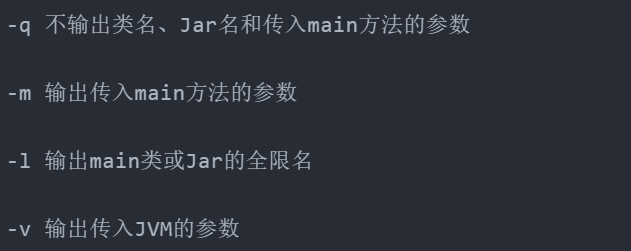
比如下面:
root@ubuntu:/# jps -m -l 2458 org.artifactory.standalone.main.Main /usr/local/artifactory-2.2.5/etc/jetty.xml 29920 com.sun.tools.hat.Main -port 9998 /tmp/dump.dat 3149 org.apache.catalina.startup.Bootstrap start 30972 sun.tools.jps.Jps -m -l 8247 org.apache.catalina.startup.Bootstrap start 25687 com.sun.tools.hat.Main -port 9999 dump.dat 21711 mrf-center.jar

二、 jstack
jstack主要用来查看某个Java进程内的线程堆栈信息。语法格式如下:
jstack [option] pid jstack [option] executable core jstack [option] [server-id@]remote-hostname-or-ip

命令行参数选项说明如下:
-l long listings,会打印出额外的锁信息,在发生死锁时可以用jstack -l pid来观察锁持有情况-m mixed mode,不仅会输出Java堆栈信息,还会输出C/C++堆栈信息(比如Native方法)
root@ubuntu:/# ps -ef | grep mrf-center | grep -v grep root 21711 1 1 14:47 pts/3 00:02:10 java -jar mrf-center.jar

得到进程ID为21711,第二步找出该进程内最耗费CPU的线程,可以使用ps -Lfp pid或者ps -mp pid -o THREAD, tid, time或者top -Hp pid,我这里用第三个,输出如下:
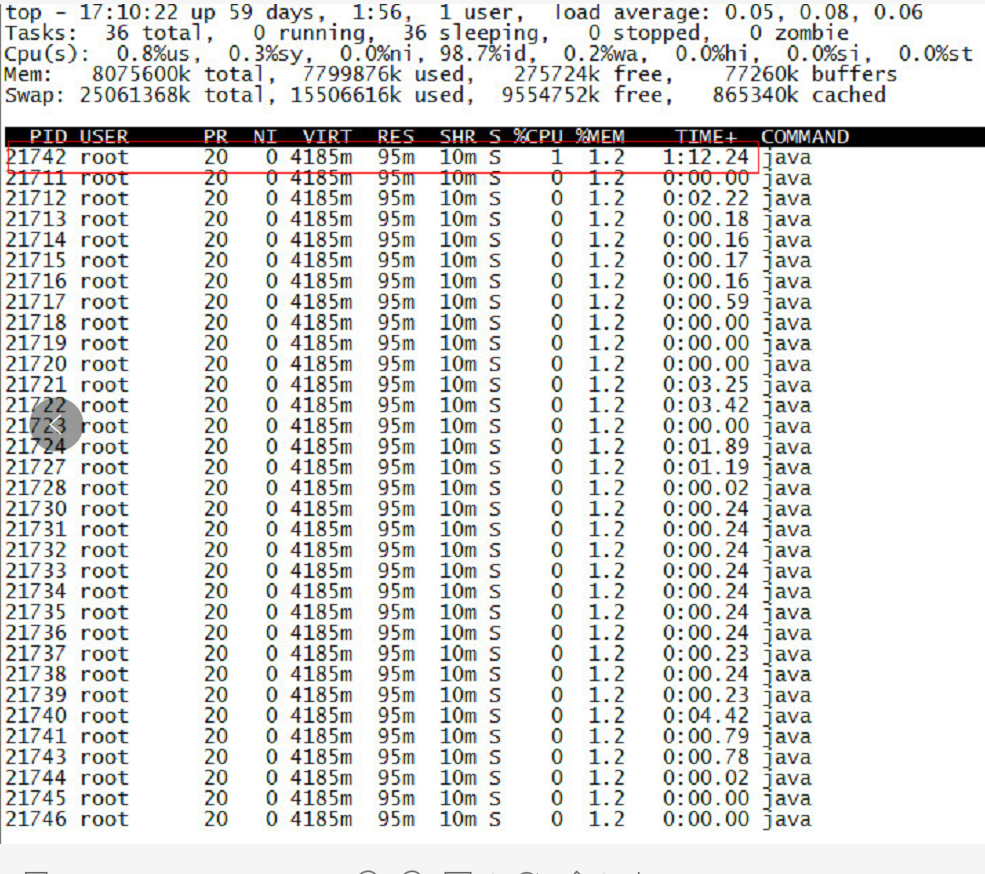
printf "%x " 21742

root@ubuntu:/# jstack 21711 | grep 54ee "PollIntervalRetrySchedulerThread" prio=10 tid=0x00007f950043e000 nid=0x54ee in Object.wait() [0x00007f94c6eda000]
可以看到CPU消耗在PollIntervalRetrySchedulerThread这个类的Object.wait(),我找了下我的代码,定位到下面的代码:
// Idle wait
getLog().info("Thread [" + getName() + "] is idle waiting...");
schedulerThreadState = PollTaskSchedulerThreadState.IdleWaiting;
long now = System.currentTimeMillis();
long waitTime = now + getIdleWaitTime();
long timeUntilContinue = waitTime - now;
synchronized(sigLock) {try {
if(!halted.get()) {
sigLock.wait(timeUntilContinue);
}
} catch (InterruptedException ignore) {
}
}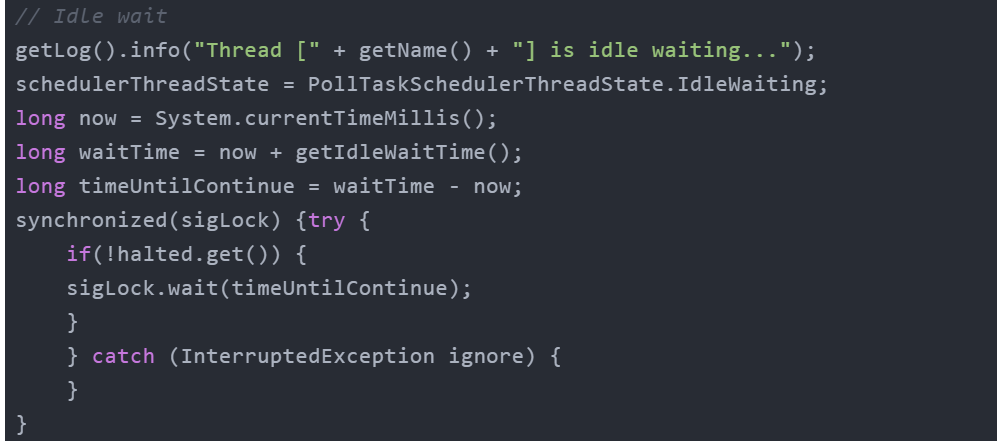
jmap [option] pid jmap [option] executable core jmap [option] [server-id@]remote-hostname-or-ip

如果运行在64位JVM上,可能需要指定-J-d64命令选项参数。
jmap -permstat pid
打印进程的类加载器和类加载器加载的持久代对象信息,输出:类加载器名称、对象是否存活(不可靠)、对象地址、父类加载器、已加载的类大小等信息,如下图:
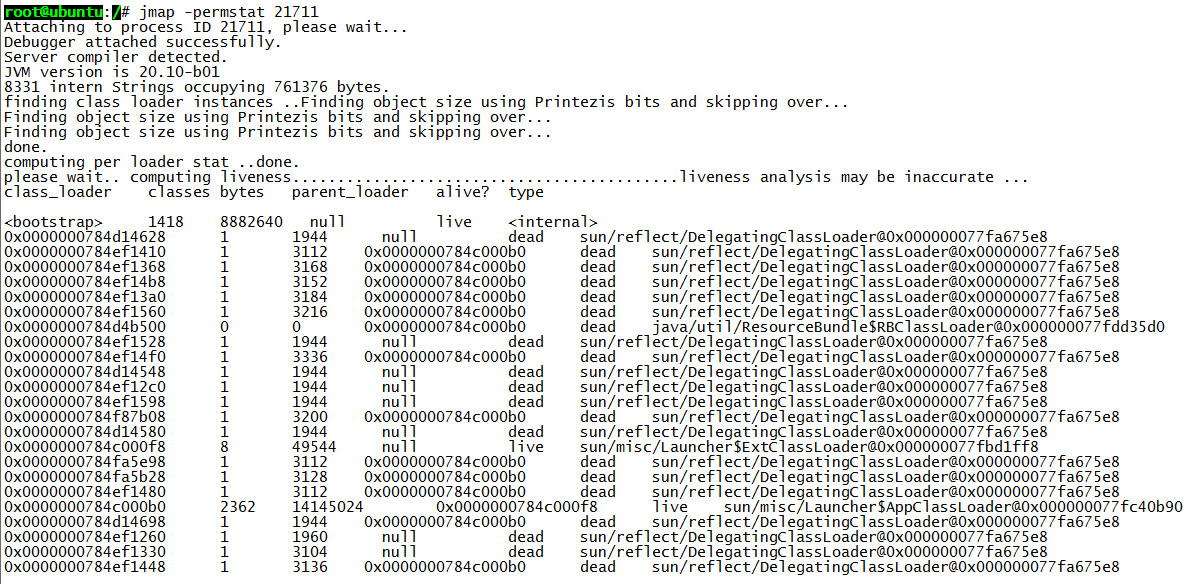
使用jmap -heap pid查看进程堆内存使用情况,包括使用的GC算法、堆配置参数和各代中堆内存使用情况。比如下面的例子:
root@ubuntu:/# jmap -heap 21711 Attaching to process ID 21711, please wait... Debugger attached successfully. Server compiler detected. JVM version is 20.10-b01 using thread-local object allocation. Parallel GC with 4 thread(s) Heap Configuration: MinHeapFreeRatio = 40 MaxHeapFreeRatio = 70 MaxHeapSize = 2067791872 (1972.0MB) NewSize = 1310720 (1.25MB) MaxNewSize = 17592186044415 MB OldSize = 5439488 (5.1875MB) NewRatio = 2 SurvivorRatio = 8 PermSize = 21757952 (20.75MB) MaxPermSize = 85983232 (82.0MB) Heap Usage: PS Young Generation Eden Space: capacity = 6422528 (6.125MB) used = 5445552 (5.1932830810546875MB) free = 976976 (0.9317169189453125MB) 84.78829520089286% used From Space: capacity = 131072 (0.125MB) used = 98304 (0.09375MB) free = 32768 (0.03125MB) 75.0% used To Space: capacity = 131072 (0.125MB) used = 0 (0.0MB) free = 131072 (0.125MB) 0.0% used PS Old Generation capacity = 35258368 (33.625MB) used = 4119544 (3.9287033081054688MB) free = 31138824 (29.69629669189453MB) 11.683876009235595% used PS Perm Generation capacity = 52428800 (50.0MB) used = 26075168 (24.867218017578125MB) free = 26353632 (25.132781982421875MB) 49.73443603515625% used ....
使用jmap -histo[:live] pid查看堆内存中的对象数目、大小统计直方图,如果带上live则只统计活对象,如下:
root@ubuntu:/# jmap -histo:live 21711 | more num #instances #bytes class name---------------------------------------------- 1: 38445 5597736 <constMethodKlass> 2: 38445 5237288 <methodKlass> 3: 3500 3749504 <constantPoolKlass> 4: 60858 3242600 <symbolKlass> 5: 3500 2715264 <instanceKlassKlass> 6: 2796 2131424 <constantPoolCacheKlass> 7: 5543 1317400 [I 8: 13714 1010768 [C 9: 4752 1003344 [B 10: 1225 639656 <methodDataKlass> 11: 14194 454208 java.lang.String 12: 3809 396136 java.lang.Class 13: 4979 311952 [S 14: 5598 287064 [[I 15: 3028 266464 java.lang.reflect.Method 16: 280 163520 <objArrayKlassKlass> 17: 4355 139360 java.util.HashMap$Entry 18: 1869 138568 [Ljava.util.HashMap$Entry; 19: 2443 97720 java.util.LinkedHashMap$Entry 20: 2072 82880 java.lang.ref.SoftReference 21: 1807 71528 [Ljava.lang.Object; 22: 2206 70592 java.lang.ref.WeakReference 23: 934 52304 java.util.LinkedHashMap 24: 871 48776 java.beans.MethodDescriptor 25: 1442 46144 java.util.concurrent.ConcurrentHashMap$HashEntry 26: 804 38592 java.util.HashMap 27: 948 37920 java.util.concurrent.ConcurrentHashMap$Segment 28: 1621 35696 [Ljava.lang.Class; 29: 1313 34880 [Ljava.lang.String; 30: 1396 33504 java.util.LinkedList$Entry 31: 462 33264 java.lang.reflect.Field 32: 1024 32768 java.util.Hashtable$Entry 33: 948 31440 [Ljava.util.concurrent.ConcurrentHashMap$HashEntry;
class name是对象类型,说明如下:
B byte C char D double F float I int J long Z boolean [ 数组,如[I表示int[] [L+类名 其他对象

还有一个很常用的情况是:用jmap把进程内存使用情况dump到文件中,再用jhat分析查看。jmap进行dump命令格式如下:
jmap -dump:format=b,file=dumpFileName pid
我一样地对上面进程ID为21711进行Dump:
root@ubuntu:/# jmap -dump:format=b,file=/tmp/dump.dat 21711 Dumping heap to /tmp/dump.dat ... Heap dump file created

dump出来的文件可以用MAT、VisualVM等工具查看,这里用jhat查看:
root@ubuntu:/# jhat -port 9998 /tmp/dump.dat Reading from /tmp/dump.dat... Dump file created Tue Jan 28 17:46:14 CST 2014Snapshot read, resolving... Resolving 132207 objects... Chasing references, expect 26 dots.......................... Eliminating duplicate references.......................... Snapshot resolved. Started HTTP server on port 9998Server is ready.

注意如果Dump文件太大,可能需要加上-J-Xmx512m这种参数指定最大堆内存,即jhat -J-Xmx512m -port 9998 /tmp/dump.dat。然后就可以在浏览器中输入主机地址:9998查看了:
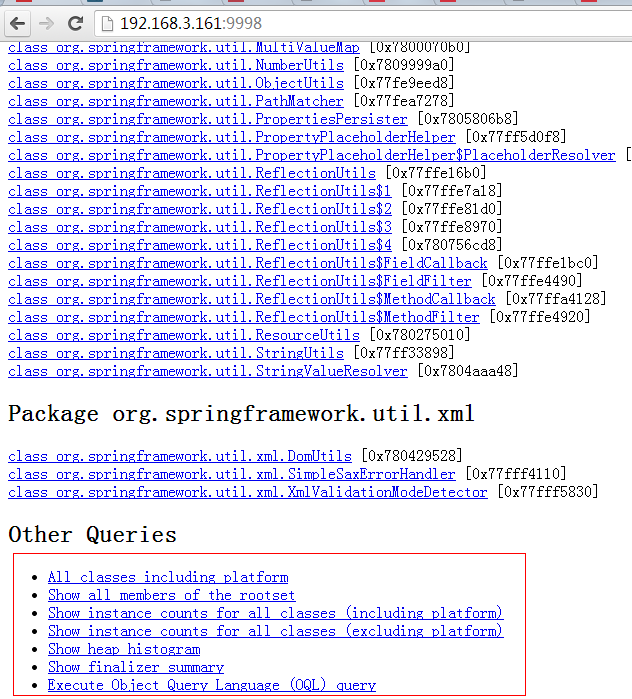
jstat [ generalOption | outputOptions vmid [interval[s|ms] [count]] ]
vmid是Java虚拟机ID,在Linux/Unix系统上一般就是进程ID。interval是采样时间间隔。count是采样数目。比如下面输出的是GC信息,采样时间间隔为250ms,采样数为4:
root@ubuntu:/# jstat -gc 21711 250 4 S0C S1C S0U S1U EC EU OC OU PC PU YGC YGCT FGC FGCT GCT 192.0 192.0 64.0 0.0 6144.0 1854.9 32000.0 4111.6 55296.0 25472.7 702 0.431 3 0.218 0.649 192.0 192.0 64.0 0.0 6144.0 1972.2 32000.0 4111.6 55296.0 25472.7 702 0.431 3 0.218 0.649 192.0 192.0 64.0 0.0 6144.0 1972.2 32000.0 4111.6 55296.0 25472.7 702 0.431 3 0.218 0.649 192.0 192.0 64.0 0.0 6144.0 2109.7 32000.0 4111.6 55296.0 25472.7 702 0.431 3 0.218 0.649

要明白上面各列的意义,先看JVM堆内存布局:

可以看出:
堆内存 = 年轻代 + 年老代 + 永久代 年轻代 = Eden区 + 两个Survivor区(From和To)

现在来解释各列含义:
S0C、S1C、S0U、S1U:Survivor 0/1区容量(Capacity)和使用量(Used) EC、EU:Eden区容量和使用量 OC、OU:年老代容量和使用量 PC、PU:永久代容量和使用量 YGC、YGT:年轻代GC次数和GC耗时 FGC、FGCT:Full GC次数和Full GC耗时 GCT:GC总耗时

五、hprof(Heap/CPU Profiling Tool):
hprof能够展现CPU使用率,统计堆内存使用情况。
语法格式如下:
java -agentlib:hprof[=options] ToBeProfiledClass java -Xrunprof[:options] ToBeProfiledClass javac -J-agentlib:hprof[=options] ToBeProfiledClass

完整的命令选项如下:
Option Name and Value Description Default --------------------- ----------- ------- heap=dump|sites|all heap profiling all cpu=samples|times|old CPU usage off monitor=y|n monitor contention n format=a|b text(txt) or binary output a file=<file> write data to file java.hprof[.txt] net=<host>:<port> send data over a socket off depth=<size> stack trace depth 4 interval=<ms> sample interval in ms 10 cutoff=<value> output cutoff point 0.0001 lineno=y|n line number in traces? y thread=y|n thread in traces? n doe=y|n dump on exit? y msa=y|n Solaris micro state accounting n force=y|n force output to <file> y verbose=y|n print messages about dumps y
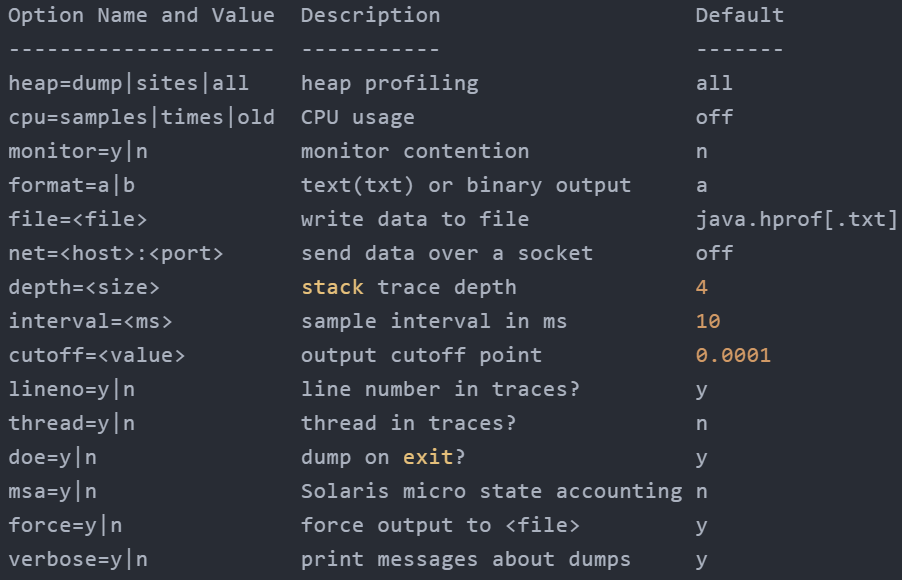
来几个官方指南上的实例。
CPU Usage Sampling Profiling(cpu=samples)的例子:
java -agentlib:hprof=cpu=samples,interval=20,depth=3 Hello
javac -J-agentlib:hprof=cpu=times Hello.java
Heap Allocation Profiling(heap=sites)的例子:
javac -J-agentlib:hprof=heap=sites Hello.java
javac -J-agentlib:hprof=heap=dump Hello.java
虽然在JVM启动参数中加入-Xrunprof:heap=sites参数可以生成CPU/Heap Profile文件,但对JVM性能影响非常大,不建议在线上服务器环境使用
来源:https://mp.weixin.qq.com/s/tjTWWxgAq8gj5PK2nzMGnQ
上一篇: 数据结构(二)--- 红黑树
下一篇: Dubbo 服务注册与发现